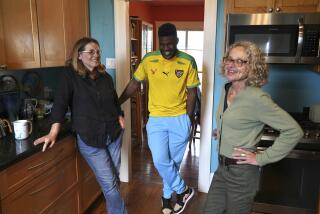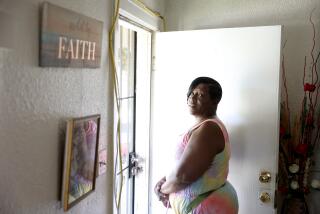Young immigrants placed in sponsor homes are at risk of abuse, experts say
Reporting from HOUSTON — A 15-year-old girl who crossed the border from Central America illegally last summer was placed by a U.S. government agency with a Santa Ana relative who demanded the girl go to work, rather than school, to earn her keep.
To pressure the girl, the relative withheld food and kept the refrigerator locked.
A 16-year-old Honduran girl was sent by the same agency to live with a man in the Baltimore area who, she later told police, had smuggled her into the U.S. and, once she joined him in Maryland, molested her.
The agency sent several Central American children to their mother in an Austin, Texas, trailer park even though she faced domestic violence charges.
The incidents — documented by advocates, police and court records — underscore what critics say is a haphazard system that frees thousands of children from government custody but leaves them vulnerable to neglect and abuse.
The federal government has created a pseudo-foster-care system for placing youths with relatives and other “sponsors” without the same levels of screening and follow-up found in state and local foster-care agencies.
“There’s no oversight,” said Rep. Henry Cuellar (D-Texas), a lawyer who represents the Rio Grande Valley, where many of the youths entered the U.S.
“Some of it is almost based on the honor system,” Cuellar said, referring to the Office of Refugee Resettlement, or ORR, which places the children with sponsors. “I have to take it on their word that that’s what they are doing.”
Agency officials said they could not respond to specific complaints cited by advocates because of the privacy of the youths involved, but emphasized that they had tried to prevent abuse with added oversight in recent months. They do not track reports of abuse, since they are not required to provide follow-up services for most children, and state child welfare agencies are not required to notify them of alleged abuse or neglect by sponsors.
More than 62,000 unaccompanied minors crossed the Mexican border last fiscal year. ORR placed 53,518 in homes while their cases are pending: 60% with parents, 30% with other family members.
An additional 39,000 minors are projected to cross the border this fiscal year, according to the nonprofit Washington Office on Latin America. As of last month, 17,439 had been placed with sponsors.
Unaccompanied children detained by U.S. Customs and Border Protection are supposed to be turned over to the Department of Health and Human Services within 72 hours. They are held at shelters, group homes and residential treatment centers until being placed with sponsors.
The department, which includes ORR, defines sponsors as adults who can “provide for the child’s physical and mental well-being and have not engaged in any activity that would indicate a potential risk to the child,” according to spokesman Kenneth Wolfe, who said the goal is to get children out of shelters and into homes.
Regardless of immigration status, “we try to place the child with a parent if possible, and if that is not possible, with a relative. And if that is not possible, with a family friend,” Wolfe said.
After the immigrant influx last summer, some lawmakers demanded to know where children were placed, and ORR posted figures online. As of July, most had been placed since the beginning of last fiscal year in Texas (9,481), California (8,113), New York (7,522) and Florida (7,309). In California, most were in Los Angeles County: 1,018 this fiscal year.
Last summer, Cuellar wrote to Health and Human Services Secretary Sylvia Mathews Burwell asking how the department screens sponsors.
Burwell replied that sponsors had to undergo a check that “consists of a public records criminal background check, self-reporting by the sponsor of criminal history or domestic violence.” Children were interviewed to uncover signs of sponsors’ criminal activity.
Fingerprints were cross-checked with FBI and Homeland Security records to see whether “there is any concern for the child’s safety, or if the sponsor is not the child’s parent or legal guardian,” she wrote.
Burwell said the department was not releasing children to those convicted of various offenses, including abuse or neglect, or those with pending criminal charges “that compromise the sponsor’s ability to ensure the safety and well-being of the child.”
Visits to screen sponsors, or “home studies,” were required by law only for some children, such as the disabled and abused. Follow-up services after children were placed were also only required for certain cases, such as trafficking victims.
Last fiscal year, ORR did home studies for 1,434 children, 2.5% of those placed, and provided post-release services to 3,989 children, about 7% of the total. Agency officials emphasized that they are not a foster-care agency and have no jurisdiction once a child is placed.
“The local or state child protective services agency and local law enforcement become responsible for following up on reported allegations of abuse or neglect,” said Cynthia Vitelli, an agency spokeswoman.
Critics said it was not clear how often or thoroughly sponsors were screened.
“The official policy is they do background checks and they do verify the family relationship, but we have found that’s not the case,” said David Walding, executive director of the Bernardo Kohler Center in Austin, which provides legal assistance to immigrant children.
Walding said that after a 16-year-old Guatemalan boy was placed with a non-relative sponsor who provided a Dallas phone number and the address of an Austin taqueria, he was unable to reach the youth. Walding worried the boy had become a human trafficking victim, and filed a report with Texas children’s services. He later heard the youth was at a ranch in Oklahoma.
ORR officials said home studies are done in person. But Caitlin Sanderson, who worked at Esperanza Immigrant Rights Project in Los Angeles last year, said some were not and left youth vulnerable — including a 16-year-old Central American girl with schizophrenia placed with her mother in Riverside County after a home study by phone by an ORR contractor in Florida. Afterward, the girl stopped taking her medications and ran away, Sanderson said.
She said a 15-year-old Central American girl who arrived last summer was also quickly placed with her father in Los Angeles without a home study that would have revealed he was a laborer sharing a studio apartment with several men.
“If you’re a foster parent, you have to take classes and be certified and if something happens to a kid in your custody, you can be held liable. That’s not really the case with sponsors. It’s really just a way for ORR to get kids into homes,” she said.
Agency officials have attempted to place more youths with sponsors more quickly especially as shelters grew crowded last summer: 96% between October 2013 and June of last year, up from 88% the previous year.
Many immigrant advocates also want children out of shelters quickly. But speedy placements without proper screening come at a price, they say.
In 2013, the agency issued an alert warning of three “fraudulent sponsors” with addresses in Colorado, Iowa and Minnesota seeking to claim multiple, unrelated unaccompanied minors.
The youths are particularly vulnerable because in immigration court, they are not provided lawyers — leaving them few advocates except sponsors.
Stephanie Canizales, a doctoral student in sociology at USC studying young Guatemalan immigrants in the U.S., met a 13-year-old who was placed with an older sister who berated the boy and forced him to work to pay off his $4,000 smuggling debt.
“He ended up never going to school. The sister’s husband became abusive toward him. This kid ended up becoming homeless,” Canizales said.
After ORR was contacted by The Times this spring, officials said they were strengthening efforts to prevent abuse.
The agency added child abuse and neglect registry checks for all non-relative sponsors and distant relatives and expanded a hotline for parents trying to find children in ORR custody to accept calls from children and sponsors reporting safety concerns.
Last month, ORR required home studies for all children released to non-relative sponsors who previously sponsored or attempted to sponsor more than one unrelated child.
Officials announced a pilot program to expand home studies to include children age 12 and under released to a non-relative sponsor. They also added post-release services for children and sponsors who have contacted the hotline within 180 days because their placement has been “disrupted” or is “at risk of disruption.” This week, ORR officials announced they would start conducting 30-day post-release “wellness checks” of children and sponsors by phone.
They have contracted “child advocates” in six metro areas, including Chicago and Los Angeles, to aid children in ORR custody and coordinate their care.
Immigrant advocates said more oversight is needed to ensure the government places children with appropriate sponsors.
Cuellar wants ORR to conduct biometric screening of all sponsors.
“When you have this pressure on HHS to place kids, we just want to make sure they’re put in the right place,” he said. But a proposal he circulated this year in Congress never made it out of committee.
Canizales, among those pushing for more oversight, recalled a 14-year-old Salvadoran girl who was placed with a distant relative in Los Angeles. He lost his job and gave her to other relatives, a couple who abused her.
“They don’t feel a sense of obligation to the child,” she said. “There has to be some kind of accountability system where children are just not placed in situations like that. If we’re just pushing children out, we’re not doing a favor to the communities, the families or the child.”
Twitter: @mollyhf
ALSO:
First female soldiers to graduate from elite Army Ranger school
U.S. wildfires scorch land at dramatic rate, but then there’s the Alaska factor
More to Read
Sign up for Essential California
The most important California stories and recommendations in your inbox every morning.
You may occasionally receive promotional content from the Los Angeles Times.











